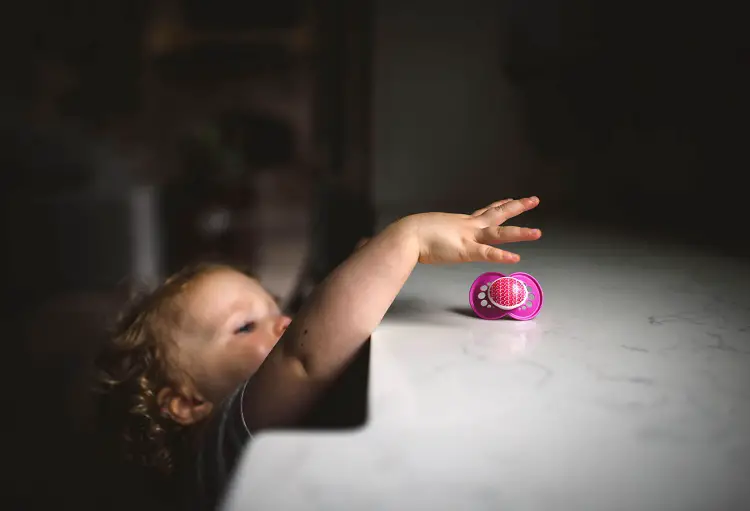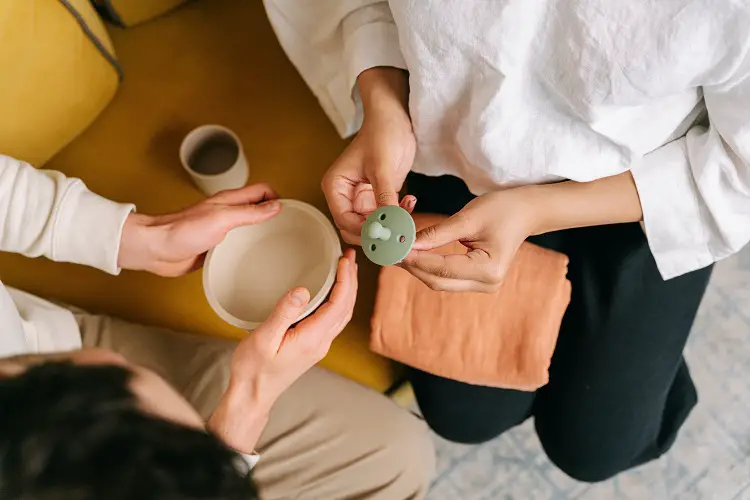It should be the topmost priority of every mother to keep her baby’s accessories clean and free of germs and trust me your baby’s pacifiers should be given topmost attention since babies put them into their mouths.
A pacifier is an essential baby item for every parent but it can be a health hazard for babies if not properly cared for and kept clean because they carry can germs.
In this article, we discuss different methods of cleaning a pacifier, how to sterilize pacifiers, and pacifier’s do’s and don’ts to keep in mind. Read On…
Methods Of Cleaning A Pacifier
1. Sticking it in Your Mouth
The bond between a child and a mother is indescribable that sometimes she might want to endanger herself provided her little one is safe and free from dangers.
This plays out when a mother uses this method to clean her baby’s pacifiers. Often you may see a mom bend over to pick up a pacifier that has fallen onto the ground.
If there’s no running water around she usually improvises a method that will help her sterilize her baby’s pacifiers and hand them over to her baby.
How do you do this, it is quite simple and easy. Simply put it in your mouth and give it a tongue bath. As mothers, there’s nothing we cannot do for our children. Mothers would rather ingest germs themselves than let them touch their babies’ lips.
2. Boiling it
Sometimes mothers use the boiling method to clean up their babies’ pacifiers and this is a good thing to do because pathogenic microorganisms are killed and their proteins and enzymes denatured.
However, the only problem with this method is that there could be leaching of chemicals, and the after-effects may pose a health hazard to the baby.
3. Sterilization
Pacifiers can be cleaned up by sterilizing either in a machine, dishwasher, or even microwave in other to make them free of germs.
Using a microwave is quite an easy way to sterilize your baby’s favorite accessory – whether it’s a new one or a tried-and-true favorite.
After sterilization remove the pacifier with caution, as water trapped in the plastic is still going to be very hot.
Let it cool for some minutes then test it before you give it to your baby by squeezing liquid onto your wrist to check the temperature.
Read Also: Pacifiers Turning Yellow? Here is Why
How To Sterilize Pacifiers

Materials for Sterilization
Depending upon which method you choose, these are some of the few things you need for effective sterilization.
- Dish soap.
- Dishrag or fresh sponge.
- Pan
- Electric sterilizer.
- Microwave sterilizer.
- Plastic baggies.
How To Sterilize Pacifiers: 5 Easy Steps
When sterilizing, you do not just sterilize, there are some steps that you must follow to ensure that your baby’s pacifier is free of germs and those steps include
1. Wash Them First
Before the sterilization proper, you must ensure that the pacifiers are clean and properly washed up.
Fill up a clean sink with hot, soapy water and wash your baby’s pacifier. When you’re washing the pacifier off, ensure you use a clean dish rag.
If your preferred choice is a sponge; ensure that the sponge you’re using is clean so that you do not end up introducing more germs instead of removing them because kitchen sponges are bacteria traps.
2. Inspect Them
After washing and you are convinced that those pacifiers are sparkling clean, check them over to make sure they’re still in good shape.
If you notice any forms of cracks, tears, or leaky parts, then you need to toss them out right away to prevent any issues.
Do not feel bad discarding them, I am sure you don’t want your baby to end up choking on a chunk of pacifier nipple.
If you notice that the nipple of the pacifier is sticky after washing, then it’s time to pitch it as well. It simply means the material is no longer in good condition.
3. Sterilization Proper
There are lots of ways to achieve sterilization and it all depends on your choice of sterilization equipment because that will determine how you go about it.
If you decide to boil a pacifier to clean it, make sure to heat the water until it is up to a full boil. After that put the pacifier in and continue the boiling for five minutes.
If you’re using an electric sterilizer, make sure you read the instructions carefully before throwing it in, this is because they are all slightly different when you’re using them.
When using a microwave sterilizer, read the instructions carefully to avoid leaving the pacifier in the microwave for too long.
When using the dishwasher as a sterilizing method, make sure that your pacifier is put on the top shelf of the dishwasher.
It shouldn’t go on the bottom rack because the heat can be too intense at that point and may likely destroy it.
Read Also: 10 Best Pacifiers 2021
4. Let it Dry
Before putting away the pacifier always ensure that the pacifier is dried out. It should air dry fairly quickly.
The handle of the pacifier can be taken and shaken off in other to hasten the drying process by removing excess water during the shaking process.
Some sterilizers have a drying feature that takes care of this step for you, but it does take extra time.
While it’s drying, avoid any form of contamination by putting it on a clean dish towel so that you do not jeopardize everything you have worked so hard for.
5. Put it Away
To keep the pacifier clean between uses, try putting it away until when needed. A good place to store properly is in a plastic Ziplock bag.
Read Also: How To Keep Pacifier in Newborn Mouth
Pacifiers Do’s and Don’ts to Keep in Mind
- Make sure breastfeeding is going well before introducing the pacifier to your baby. Make sure you talk to your baby doctor about this, especially if you feel your baby needs to use one at this early stage. The only exceptions are premature or sick babies in the hospital who will know can benefit from using one for comfort.
- Confirm first if your baby is hungry, tired, or bored before giving him a pacifier. These little things are very important.
- Ensure your baby’s pacifier is free of germs before giving it to your baby. You can either sterilize in boiling water for 5 minutes, electric sterilizer, microwave, or dishwasher. You can also stick it in your mouth but this method can also spread germs from you to your baby.
- Make sure the pacifier is free of cracks or tears before giving it to your baby.
- Avoid giving your baby a pacifier right after medication (such as pain reliever, antibiotics, or vitamins). This is because some of these medications can cause a breakdown of the material in the pacifier. If there are cracks or tears, toss them out right away.
- You should replace the pacifier every two months.
- Do not dip the pacifier in sugar or honey, doing this will hurt your baby’s teeth. Honey can lead to a type of food poisoning called botulism.
- Do not tie a pacifier around your baby’s neck to avoid strangulation and death. Instead, use clips with short ribbons attached to the pacifier. They are available in the market and are safe to use.
- Avoid making your pacifier out of bottle nipples, caps, or other materials. These can pose some serious health hazards to the baby or possibly result in death.
- Don’t let your toddler crawl or walk around with his pacifier.
- Give your baby the pacifier only when he/she needs it for comfort. Using the pacifier all day long can affect the baby’s ability to learn how to talk and can cause dental problems.
- Do not let your baby or child chew on his/her pacifier. This could damage the pacifier and could also lead to choking and death. Always go for pacifiers with a large shield to prevent this.
Related Posts:
- How To Clean A NUK Pacifier (5 Easy Steps)
- Does Wubbanub Help Keep Pacifier in Mouth
- How To Clean Avent Pacifier
- Pacifier Alternative (For Babies & Toddlers)
- How Many Pacifiers Do I Need? Find Out
Wind Up
We hope this article has given an in-depth discussion to answer your question, how to sterilize pacifiers.
Bear in mind that having the right information will help you to determine what’s best for you and your baby without damaging his favorite pacifier or exposing his weak immune system.
Still, need to know more? Learn How To Stop Baby Crying At Night?
